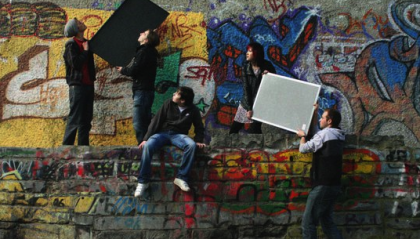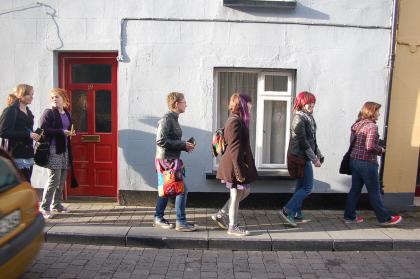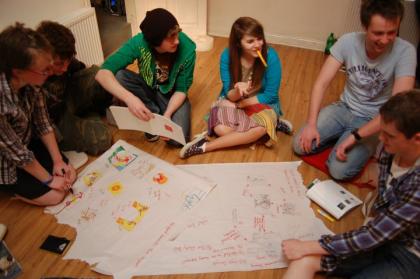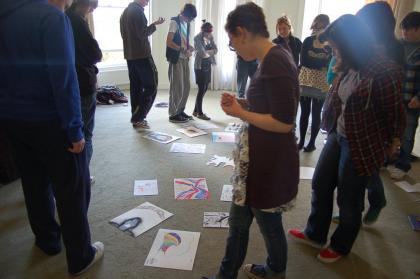By Jean Tormey

Between 2009 and 2011, a facet of the Butler Gallery’s education programme, the Red Square youth programme, was initiated and flourished with the realisation of two major projects. Among the aims of the programme are to develop creative and critical thinking skills among young people, to encourage interests and passions outside of school hours, and for young people to give their time voluntarily to a project. The programme also hopes to make the gallery more accessible - to encourage use of its space for social encounters, where young people can engage with, and/ or participate in, high quality arts experiences.
This paper is an exploration and analysis of the origins and development of Red Square, reflecting on how it echoes the above definition of youth arts. It focuses on the unique setting of an art gallery as a context for youth arts practice, the variables that assist the development and success of such a youth programme in the Butler Gallery’s experience, and its potential to become fully youth-led, accessible to all communities living in Kilkenny and integrated within the operations of the gallery as a whole.

A note on national context
The requirement for galleries and museums to focus on the development of education programmes that sit alongside exhibition programmes in Ireland over the past two decades has been driven largely by the Arts Council of Ireland and inspired by the quality and impact of programming at the Irish Museum of Modern Art. Within this, youth participation has traditionally occurred through schools and community programmes.
Internationally, consultation and peer leadership within youth programmes in a gallery setting has been a feature of gallery education practice since the early 1990s. In more recent years in Ireland, a focus on working with those of secondary school age informally in galleries in a consultative and often peer-led approach has been apparent, with the setting up of programmes such as Young Model at the Model, Sligo, Studio 8 at IMMA and Young Curators Inc. at Dublin Contemporary. For the Butler Gallery, the Arts Council’s Young Ensemble Scheme financially supported the development of the young people’s programme at the Butler Gallery in 2010.

Red Square Roots
The Butler Gallery has run events and residencies for young people of secondary school age as part of its core programme since 2004; but nothing on a voluntary and informal basis. Having seen at first hand the full impact of the youth programme at Tate Liverpool, I set about developing a youth programme at the Butler Gallery in 2008, looking at models such as Young Tate, but also the Irish context, keeping in mind the wealth and quality of existing non-gallery youth arts practice in Kilkenny such as Barnstorm Theatre, Young Irish Filmmakers and the existence of 2 youth centres - Ossory Youth and the Drum, run by Foroige.
To test the water, throughout 2009/ 2010, workshops were programmed relating to different exhibitions and artists working at the gallery. One such workshop was ‘Without End’, inspired by a David Godbold exhibition at the gallery in 2009 led by artist Julie Moorhouse and writer Grace Wells. It resulted in a written critique of the exhibition by a participant posted on a local youth website, ‘Punch the Sphinx’. The informative, insightful and relaxed nature of the article, and the entertaining approach of the young person led us to think about instigating a young critics group who, with heightened tools and interaction with artists, curators and critics, would engage in more elaborate, informed and extensive criticism that could be shared with peers, exhibition visitors and the media.
The first young critics project took place in 2010 during the Kilkenny Arts Festival, the group calling itself the ’Red Square Kibosh’. For the first time, we had a funding source dedicated to this particular strand of the education programme’s practice (and support from the Kilkenny Arts Festival and youth centres in Kilkenny), including a budget for marketing, documentation and evaluation of the project. Although a loose structure was in place for the duration of the first young critics project, the young people decided on their manifesto, their name and which aspects of the Kilkenny Arts Festival they would critique. They met and interviewed artists and curators, channelling the results of these interviews into the content of their critiques online and in the local press.
The project strengthened the local and public profile of the gallery’s youth programme and enabled us to experience our research in practice, viewing the effects of a gallery-based youth programme on young people in terms of personal development, the development of career interests, making friends and having fun. Furthermore, it mobilised a group of young people who were interested in continuing to work with us and in initiating youth projects themselves.
Red Square Returns
In 2011 Red Square secured more funding and engaged in a second round of the young critics project (’Nothing if not Critical’). This time there was a desire to do and see less in the festival, while being more genuinely critical about the artwork they chose to critique. Also, the project spent more time discussing criticism and what it meant to be critical with facilitators focusing on certain aspects of the visual arts and theatre alone (working with artists Etaoin Holahan, Kate Strain and Anna Galligan of Barnstorm Theatre to achieve this), and worked with Young Irish Filmmakers on a documentary film of the project. The emphasis was on the group working together to write critiques rather than individually at home, and as a result the blog and the overall running of the project was more streamlined and successful, with the group’s opinions (captured at their public discussion event at the end of the festival) being featured generously in the Irish Times write up of the festival.
This development in the evolution of the young critics group had the benefit of learning from another major project - a young curators project entitled ’From Us, Through Them, To You’, which consisted of a number of phases of training with Etaoin Holahan, Anna Galligan and Mick Minogue, and a youth-curated exhibition at the gallery. This project moved the youth programme on in leaps and bounds, giving it a voice in the very central space of the gallery, and exposing the positive complications that involving 12 other voices adds to a gallery’s system and operating structure. The project emerged among a small group of young people who were involved in the first young critics project, and who (in collaboration with the gallery) successfully applied for a Leargas Youth in Action grant. A bigger group was gathered together in January 2011 and engaged in different phases of training over five months - creative & critical, research & communication, and project & event management. Given the tangible and public end-product of the process, the usual systems of the Butler Gallery were challenged by the collective curating of the exhibition, as the group made the final call - not just about choosing works, but deciding on the look and feel of the invite, the opening and most importantly, the hanging of the work.

Learning Curve
The development of the youth programme proved a steep learning curve for all involved. On reflection, we learnt that one of the most important tenets for the success of a gallery-based youth project is genuine organisational support from start to finish, where colleagues are sympathetic to and supportive of young people and the nature of what they are trying to do. Confident, clear and consistent communication from the point of view of education staff managing the project is of utmost importance, and the ability to mediate the needs of the group within the overall structure of a gallery setting.
A dedicated funding strand is crucial to a substantial youth programme that can spend on dissemination and marketing as well as activity and content. Facilitation needs to be objective, informed and inclusive, with realistic and collaboratively agreed aims of any particular project mapped out from the very beginning with the young people involved. Leading on from this, the construction of a loose and flexible structure is necessary, often referred to as ’scaffolding’ in UK youth arts practice.
An emphasis on both process and product, with an open-minded and flexible attitude to the latter helps the success of a project. Adequate time to realise projects may seem an obvious point, but was pertinent in our young curators project, as we had a tight turn around to organise the exhibition following the completion of training. The capturing of ideas that emerge along the way, while reflecting on and reviewing these is important, as are the evaluation, research and continual development of ideas. During the project, a mix of activities aimed at different learning styles was necessary, and at the outset a connection with schools and teachers was crucial for the attraction of participants to the project.
Red Square Future
In the early days, our concerns were simply about gathering a group of young people who were interested in taking part in workshops and projects at the gallery. Then it became about the retention of these young people and the generation of new ideas and funding for projects. More and more, Red Square became about giving the young people we were working with a genuine voice in the development and growth of the programme. Now, I believe it should be about accessing and empowering young people from different cultural backgrounds to participate in the programme. Through the Red Square projects, the Butler Gallery has developed an ethos that is about nurturing the audiences of today in a way that makes sense to their lives now, rather than simply building an audience of the future.
Bibliography & Further Reading
Websites
Arts Council of Ireland
http://www.artscouncil.ie/en/areas-of-work/introduction.aspx
Art-Youth-Culture: FYI event
<http://212.126.36.41/~futurear/7/>
Punch the Sphinx
<http://punchthesphinx.com/announcements/david-godbold-exhibition-and-workshop-butler-gallery/.>
Red Square Kibosh
http://redsquarekibosh.wordpress.com/
Articles & Journals
Hart, Roger from (1992) Children’s Participation: From Tokenism to Citizenship. UNICEF.
’The PACE of Gallery Education in Ireland today’, co-written by (then) members of the
Partnership for the Arts and Creative Education (PACE) Louise Allen, Marie Louise Blaney, Katy Fitzpatrick and Jean Tormey, Visual Artists Ireland Newsletter, Spring 2010.
ed. Raney, Karen, Engage, the International Journal of Visual Art and Gallery Education, ’Young People and Agency, no. 22, 2008.
Books
ed. Allen, Felicity (2011), ’Education’, Documents of Contemporary Art: Education, London: Whitechapel Gallery.
ed. Mick Wilson and Paul O’Neill (2009), Curating and the Educational Turn.
Devlin, M., Healy, D., (2007), Work in Progress: Case Studies in Participatory Arts with Young People. Dublin: National Youth Arts Programme.
O’Neill, C., (2006), Mapping Lives, Exploring Futures: The Mapping Art Project. Dublin: Irish Museum of Modern Art.
Biography
Jean Tormey was Education Curator at the Butler Gallery for 3 years, from 2008 - 2011 where she set up Red Square, the Butler Gallery’s youth programme, and project- managed the development of ’What is Art’, a book designed and published by Kids’ Own Publishing Partnership celebrating 10 years of the Butler Gallery’s family programme, ’Solas’. Previously, she had been Public Programmes Curator at Tate Liverpool for 3 years after undertaking internships in education departments at the Museum of Modern Art, New York and the Guggenheim following completion of a Masters in Arts Management and Cultural Policy (2004). Prior to this, Jean completed a BA in Art History and French (2001) and spent 2 years teaching English in Rome. In 2011, Jean moved to London to pursue freelance opportunities and is currently Education Curator: Schools & Families at the Whitechapel Gallery, London.


No comments added